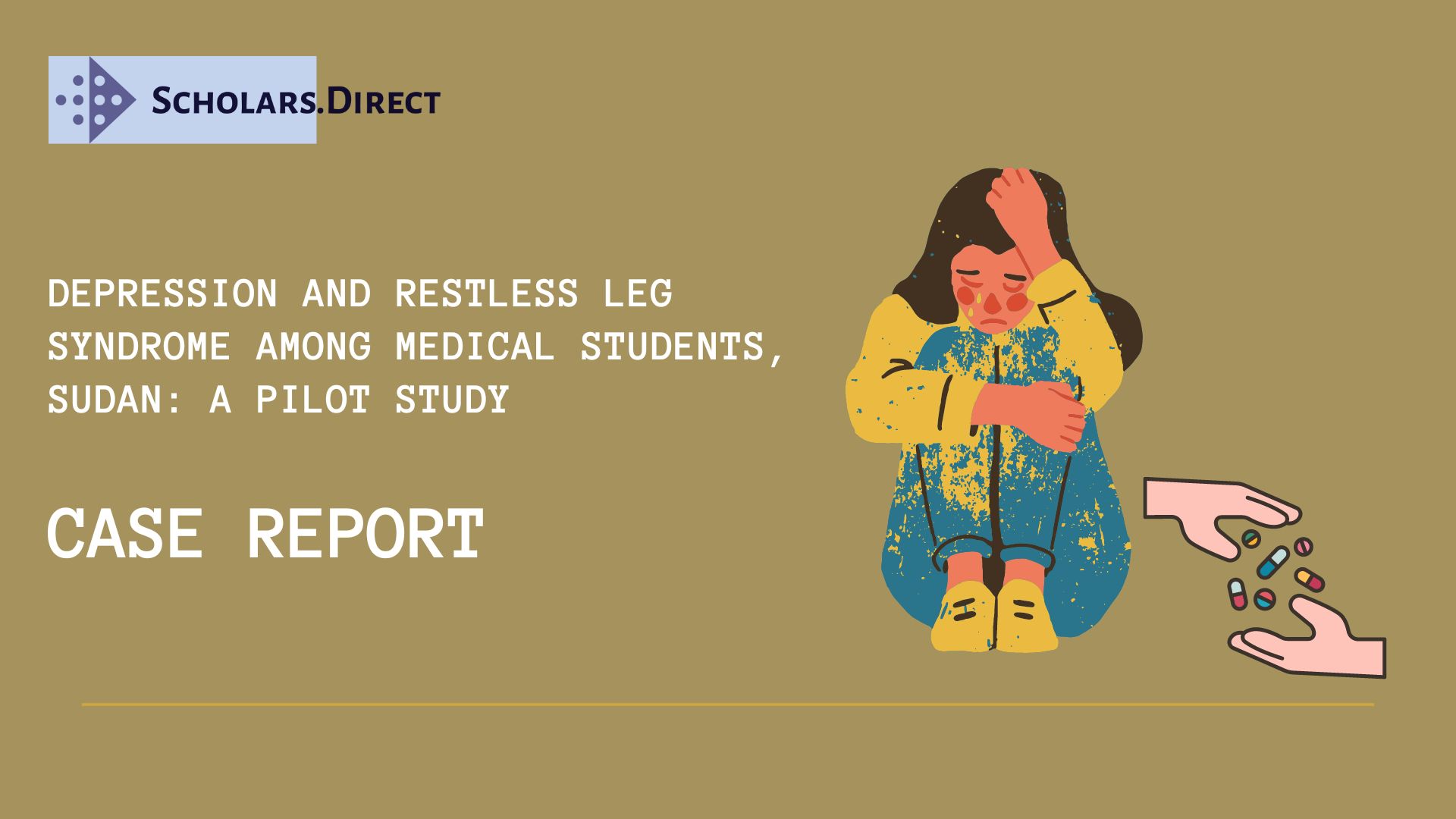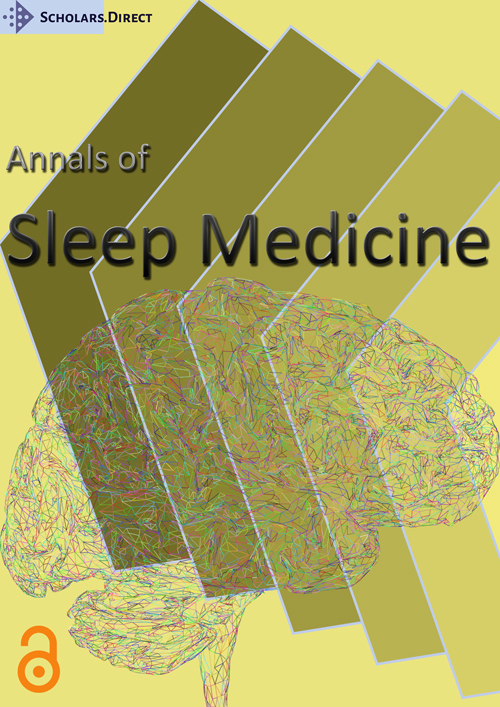Depression and Restless Leg Syndrome among Medical Students, Sudan: A Pilot Study
Abstract
Background
Depression and restless leg syndrome may affect academic achievement among medical students. This study assessed the rate of depression among the final class medical students in the College of Medicine, Omdurman University.
Subjects and methods
This pilot study was conducted among the 6th year medical students in the Faculty of Medicine, Omdurman University, Sudan, during the period from June 2018 to August 2018. A structured questionnaire based on the demographic data and the HADS questionnaire for depression and the Restless Syndrome International Study Group Guidelines, all the participants signed written informed consent, and the statistical Package for Social Sciences (SPSS) was used for data analysis. A P-value of < 0.05 was considered significant.
Results
Out of 65 students (80% males), depression was reported in 73.8% of students (33% severe) and males were more affected, P-Value < 0.05. Restless leg syndrome was reported in only 1.5% of students.
Conclusion
Depression was prevalent among the 6th year medical students and was commoner among males, the restless syndrome was found in only a minority, further larger multicenter studies assessing the risk factors of depression are needed.
Keywords
Depression, Restless leg syndrome, Medical students, Sudan
Introduction
Depression is a mental illness that presents with persistent low mood and a sense of despair, the affected person feels hopeless, sad, frustrated, and have low self-esteem [1]. Depression is one of the most prevalent health disorders, despite the wide availability of effective treatment depression is often under-diagnosed and treated. University students are a unique sector of the community that their continuous academic demands pose more pressure on them, furthermore, the University is a transition period in which some students may move away from their family home for the first time, and faced financial difficulties; These may be risk factors for depression [2].
Previous literature reported that nearly two-thirds of University students leave prematurely before completing their studies due to the inability to manage depression, anxiety, and maladjustment [3].
Restless legs syndrome (RLS) is among the most common neurologic disorders, affecting up to 10% of adults in the developed countries and Clinically significant Restless legs syndrome is estimated to affect 2-3% of the adult population [4-7].
The restless leg syndrome is a relatively common morbid disorder in childhood and adolescence although it is commonly overlooked due to it's a typical presentation [8]. Restless leg syndrome has been linked to cognitive impairment and depression through sleep disturbances and vascular causes [9]. No researchers have studied depression and restless syndrome among medical students in Sudan, the surveys conducted in Western and Asian countries may not apply to this country.
Thus, we conducted this research to study depression and restless syndrome among medical students, Sudan.
Subjects and Methods
This cross-sectional study was conducted among the final class medical students, Omdurman Islamic University during the period from June 2018 to August 2018. Sixty-five students were randomly chosen from a total of 130 students in a ratio of 1:1. The participants were invited to sign a written informed consent from then responded to a questionnaire based on the HADS questionnaire for depression and the Restless Syndrome International Study Group Guidelines. The HADS questionnaire for the diagnosis of depression consists of seven components each one with four choices ranging from zero = no abnormality and three = the greatest dysfunction. The questions are: I still enjoy the things I used to enjoy, I can laugh and see the funny side of things, I feel cheerful, I feel as if I am slowed down, I have lost interest in my appearance, I look forward with enjoyment to things, and I can enjoy a good book or radio or TV program. Those who score [8-10] from the total of 21 were borderline, [11-15], moderate depression, and > 15 severe depression with a specificity of 0.79 and a sensitivity of 0.83 [10,11]. The criteria for the restless leg syndrome include the presence of four criteria for the diagnosis [12,13]: An unpleasant sensation in the limb with a desire to move, the unpleasant sensation increases with rest and at night, and decreases with movement. The age, sex, grade in the last semester, if left-handed or right-handed, the presence of diabetes, anemia, and other chronic diseases were also recorded. The Statistical Package for Social Science (SPSS version 20, Chicago) was used for data analysis. The T-Test and the Chi-square test were used to compare numerical and categorical data. A P-value < 0.05 was considered significant. The Ethical Committee of the Medical College, Omdurman Islamic University approved the research.
Results
Out of 65 final class medical students (80%) males, their ages ranged from 21-26 years with a mean of (23 ± 3.5), 86.2% were right-handed, diabetes was found in 9.2%, 10.8% were diagnosed with anemia, 6.2% with bronchial asthma, while eczema was found in 4.6% (Table 1). In the present study, the highest score was for I am not enjoying the things I used to enjoy (2.04 ± 0.79), followed by I have lost interest in my appearance (1.92 ± 0.79), and I cannot enjoy a good book or radio or TV program (1.89 ± 0.77) (Table 2). Depicted the components of the HADS questionnaire. In the present study, 73.8% of the medical students fulfilled the HADS criteria for depression (40% moderate depression, and 33.8% severe depression), 24.7% were borderline for depression, while only 1.5% were normal. The restless leg syndrome was reported in only 1.5% of medical students (Table 3). Table 4 depicted a comparison between students with depression and their counterparts in which: Depression was commoner in males with significant statistical difference (86.7% vs. 13.3%), no significant statistical differences were found regarding age (22.10 ± 1.57 vs. 22.00 ± 0.79, P-value = 0.795, anemia (12.5% vs. 0.0%, P-value = 0.126, diabetes mellitus (8.3% vs. 17.6% , P-value = 0.287, and the grades in the previous semester (75%, 58.3%, and 88.2% for Excellent, Very good, and Pass scores respectively, P-value = 0.413.
Discussion
The medical student's population is increasing every year, due to the high academic demand and competition, there is an increasing risk of mental disorders including depression. Studies addressing the prevalence of depression among medical students are scarce worldwide. In the present study, nearly three-quarters of the final class medical students were depressed in similarity to previous research published in India [14] and reported a high rate of depression (71.25%). The current study findings were in line with another research publisher in Korea and found depression in 65.6%. The present finding was higher than a similar study in Sudan [16] which concluded depression in 50% of medical students. The high rate of depression in the present sample is alarming in particular the medical students scored the lowest for enjoyment in things that they used to enjoy and looking forwards to enjoyment. All those who scored high in the HADS questionnaire for depression did not seek medical help. The final medical students are the near future doctors, leaving this important sector without evaluation, and management with objective measures may compromise the patient's care with deleterious consequences. Furthermore, if unidentified and treated at the earliest depression is associated with burnout and suicidal ideation [17].
In the present study, the restless syndrome was found in 1.5% of final class medical students, the present findings were lower than the results of a study conducted among medical students in Egypt [18] and observed that 10% of medical students fulfilled the criteria for restless leg syndrome.
Conclusion
Depression was prevalent among the final class medical students and was commoner among males, while restless leg syndrome was not common. Further larger multi-center studies investigating the risk factors of depression are needed.
Conflict of Interest
None to declare.
References
- Allen RP, Walters AS, Montplaisir J, et al. (2005) Restless legs syndrome prevalence and impact: REST general population study. Arch Intern Med 165: 1286-1292.
- Allen RP, Bharmal M, Calloway M (2011) Prevalence and disease burden of primary restless legs syndrome: Results of a general population survey in the United States. Mov Disord 26: 114-120.
- Hening W, Walters AS, Allen RP, et al. (2004) Impact, diagnosis and treatment of restless legs syndrome (RLS) in a primary care population: the REST (RLS epidemiology, symptoms, and treatment) primary care study. Sleep Med 5: 237-246.
- Allen RP, Stillman P, Myers AJ (2010) Physician-diagnosed restless legs syndrome in a large sample of primary medical care patients in Western Europe: Prevalence and characteristics. Sleep Med 11: 31-37.
- Angriman M, Cortese S, Bruni O (2016) Somatic and neuropsychiatric comorbidities in pediatric restless legs syndrome: A systematic review of the literature. Sleep Med Rev 34: 34-35.
- Waleed Al-Qadhi, Saeed Ur Rahman, Mazen S Ferwana, et al. (2014) Adult depression screening in Saudi primary care: Prevalence, instrument, and cost. BMC Psychiatry 14: 190.
- Zakiya Al-Busaidi, Kamlesh Bhargava, Aida Al-Ismaily, et al. (2011) Prevalence of depressive symptoms among university students in Oman. Oman Med J 26: 235-239.
- Porter OF (1989) Undergraduate completion and persistence at four-year colleges and universities: Completers, persisters, stop-outs, and drop-outs.
- Rist PM, Elbaz A, Dufouil C, et al. (2015) Restless legs syndrome and cognitive function: A population-based cross-sectional study. Am J Med 128: e33-e39.
- Zigmond AS, Snaith RP (1983) The hospital anxiety and depression scale. Acta Psychiatr Scand 67: 361-370.
- Ingvar Bjelland, Alv A Dahl, Tone Tangen Haug, et al. (2002) The validity of the hospital anxiety and depression scale. An updated literature review. J Psychosom Res 52: 69-77.
- Allen RP, Picchietti D, Hening WA et al. (2003) Restless legs syndrome: Diagnostic criteria, special considerations, and epidemiology. A report from the restless legs syndrome diagnosis and epidemiology workshop at the National Institutes of Health. Sleep Med 4: 101-119.
- Skomro RP, Ludwig S, Salamon E, et al. (2001) Sleep complaints and restless legs syndrome in adult type 2 diabetics. Sleep Med 2: 417-422.
- Kumar GS, Jain A, Hegde S (2012) Prevalence of depression and its associated factors using beck depression inventory among students of a medical college in Karnataka. Indian J Psychiatry 54: 223-226.
- Kim B, Roh H (2014) Depressive symptoms in medical students: Prevalence and related factors. Korean J Med Educ 26: 53-58.
- Dafaalla M, Farah A, Bashir S, et al. (2016) Depression, anxiety, and stress in sudanese medical students: A cross sectional study on role of quality of life and social support. American Journal of Educational Research 4: 937-942.
- Azad N, Shahid A, Abbas N, et al. (2017) Anxiety and depression in medical students of a private medical college. J Ayub Med Coll Abbottabad 29: 123-127.
- Shalash AS, Elrassas HH, Monzem MM, et al. (2015) Restless legs syndrome in Egyptian medical students using a validated Arabic version of the restless legs syndrome rating scale. Sleep Med 16: 1528-1531.
Corresponding Author
Hyder Osman Mirghani, MD, Medical Department, Faculty of Medicine, University of Tabuk, PO Box 3378 Tabuk 51941, Saudi Arabia.
Copyright
© 2020 Mirghani HO. This is an open-access article distributed under the terms of the Creative Commons Attribution License, which permits unrestricted use, distribution, and reproduction in any medium, provided the original author and source are credited.





